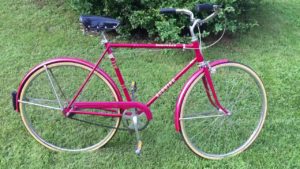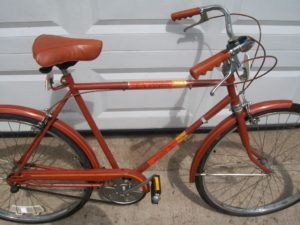
Boomer kids grew up on two wheels. From the time the training wheels came off, we were spotted buzzing around town on our Sting-Rays, or on less expensive banana-seated clones.
However, many of us had more technologically sophisticated rides. Perhaps we inherited them from our parents or older siblings, or perhaps the non-conformists among us showed our rebellious traits at an early age by opting for them over the high-handlebarred models that everyone else preferred.
The result was the fairly common sight of three-speed bikes on the 1960’s streets where we lived.
The three-speed bike has a venerable history. Before the invention of the automobile, bicycles were seen as an alternative method to getting around town for those without a horse. And let’s face it: it was difficult for a city dweller to own a horse, so the bicycle may well have been an essential part of his or her life.

Thus, around the turn of the century, technological developments were taking place very rapidly on bicycles. In 1909, the British Raleigh bicycle, equipped with a Sturmey Archer 3-Speed hub, started production. Thus began the three-speed revolution.
The three-speed hub allows for variable gear ratios. This makes for easier hill climbing as well as greater speed on level areas.
Comfort was the priority of the three-speeds. Most of them had a spring-loaded cushioned seat. They also had upright handlebars that your hands found naturally comfortable to grasp. The shifter might have been found on the bike frame in the form of a “stickshift,” but was more likely found near the right handgrip.
Front and rear brake levers were also found attached to the handlebars. The three-speed hub made it impossible for the bike to use the coaster brake that most single-speed models used.
The bikes were designed for a leisurely trip through town. Many were equipped with front or rear baskets. All of them came with fenders, to prevent that nasty road grime from covering your back while pedaling in wet conditions.
What they weren’t was cool. Riding around on a three-speed meant that you were not:
A sports jock
A babe magnet
Likely to be voted Most Popular in school
More concerned with image than functionality
Afraid to be seen riding a contraption more suited for your Uncle Joe
At the time, non-conformity was a course taken by a courageous few. The rest of us were slaves to image, and were sadly likely to poke fun at those who weren’t.
The three-speed bike was a classic design that had the further advantage of being extremely durable. Bike frames were generally made of good old heavy steel. The gear mechanism was sealed against the elements. The tires were massive rubber monstrosities, with thick treads, designed to go thousands of miles. Try THAT on those skinny 27″ tires that came on the later ten-speeds.
Thus, many a three-speed pedaled by a Boomer kid was a hand-me-down. Those bikes could last for decades with just a bit of care and the provision of a dry place of storage.
Nowadays, three-speeds have their fan clubs. For instance, take a look at the 3-Speed Adventure Society, who enjoy dressing up in tweed and hitting the road like it was 1920.
It was the ten-speed that caused an explosion in bicycling in the 1970’s, and a future article will cover that in full. But here’s a doff of the Brooklyn Dodgers baseball cap to the three-speed: the triumph of function over form.